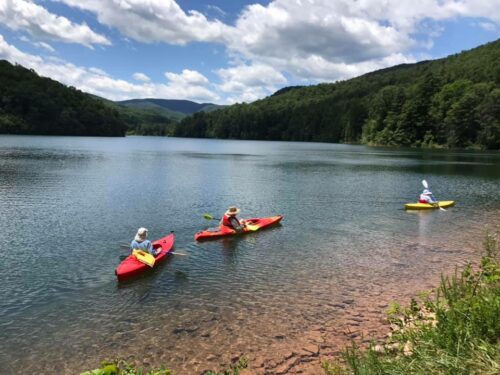Inherently we know it—the Shenandoah Valley is a special place filled with special places. Trying to define what that means has consumed us for decades. Thus, we have taken to creating lists and designations on both the state and national level. There are scenic rivers and roads, historic battlefields, rare natural habitats, and significant buildings with a wide variety of designations and honorifics.
Why put something on a list? Is this just an obsessive pastime for Virginians (and Americans)? The answer is no. In the Alliance’s world of preservation and conservation, lists and designations actually have a higher calling, perhaps best communicated in four “preservation Ps”—Preserve, Protect, Promote, and Prosper.
The National Park Service and the Virginia Department of Historic Resources, for instance, offer landowners and communities opportunities to list their unique historic resources on the National Register of Historic Places, the Virginia Landmark Register, or to receive designation as a National Historic Landmark. Designations come only after extensive documentation, review, and scrutiny.
While earning a place on a list is an honor, there are other benefits. Any proposed development that uses government funding—be it a cell tower, a shopping mall, or a road widening—must take into consideration impacts to historic resources. Recently, the ancient stone walls in the path of the Atlantic Coast Pipeline were deemed eligible for the National Register of Historic Places. That listing forced pipeline developers to hire archaeologists who carefully documented and moved the walls to a safe storage area for future reassembly.

Listing on the National Historic Lookout Register (nhlr.org) raised awareness of the cultural value of the Elliott Knob Fire Tower (1948) located on the George Washington National Forest in western Augusta County. The listing also protected the tower location from development when a large radio antenna, proposed to be built adjacent to the fire tower, was denied based in part on the negative impact the project would have on the historic tower and site at the top of the mountain. (Photo credit: Nancy Sorrells)
Twenty years ago, a Shenandoah County group formed the Shenandoah Preservation League with the purpose of earning Virginia Scenic Byways designations for rural roads. Achieving a place on the scenic byways list allows local communities to promote their special places to visitors and apply for grant funds directed toward historic preservation and tourism projects. Although the Shenandoah group is no longer active, members realized their goal and designated the network of Shenandoah County Scenic Byways that exists today.

In Shenandoah County, the rock wall restoration at St. Paul’s Lutheran Church in Jerome was eligible for a grant program offered by the Virginia Department of Transportation for historic preservation projects along Virginia Scenic Byways. (Photo credit: Kim Woodwell)

Partially because of the Blue Ridge Tunnel’s historic designations, millions of dollars of funding have been leveraged to preserve this special rails-to-trails greenway. Promotion has quickly turned the tunnel into a recreational and tourist destination. (Photo credit: Nancy Sorrells)
The funding that designations can unlock has come in handy with the restoration of the Claudius Crozet Blue Ridge Tunnel that goes under Afton Mountain and connects Nelson County to Augusta County. The newly-opened rails-to-trails project, which restored the 4,273-foot railroad tunnel originally built using the labor of Irish immigrants and enslaved African Americans in the 1850s, had been abandoned for nearly 60 years when work began 20 years ago.
Eligibility for the National Register of Historic Places and its current listing as a National Historic Civil Engineering Landmark has helped leverage a variety of funds that not only protected and preserved this unusual cultural resource but allowed it to be promoted as a public rails-to-trails greenway. After decades of decay, prosperity reigns. Since fall, over 50,000 people have visited the tunnel, and the local economies have felt the economic boost.
Recognizing the power of organizing lists, Virginia recently created ConserveVirginia, a data-driven process to help identify and map lands and places that have high conservation value. But, ConserveVirginia only includes scenic and historic resources that are formally listed in state or federal programs, so getting the Valley’s unique places listed is key for our region to leverage funds that can preserve, protect, and promote.
ConserveVirginia includes the following designations:
Scenic, historic and cultural resources:
• national/state scenic byways
• state rivers
• all-American roads
• national scenic trails
• national historic trails
• national millennium trails
• national recreation trails
• national historic landmarks
• priority 1 class A battlefield study areas
• national register of historic places
• Virginia landmarks register
• American unit involvement battlefields
Natural habitat and ecosystem diversity:
• native brook trout streams
• natural heritage conservation sites (includes rare aquatic and terrestrial communities and rare plant and animal species)
Prosperity as an important byproduct of the effort of listing the Valley’s special places is not to be forgotten. For every dollar invested in conservation and tourism, four dollars of economic value is returned to the local economy and clean water and air, increased habitat, productive farmland, enhanced recreation opportunities prevail.
Do you know of a special spot in the Shenandoah Valley deserving one of these designations?
If so, reach out, and we can help get you started on the process. The more we formally honor the unique places and resources that surround us, the better our chances to preserve them.
Designations in our counties
Explore the stories below to see examples where scenic and historic designations have made a difference in Valley communities.







